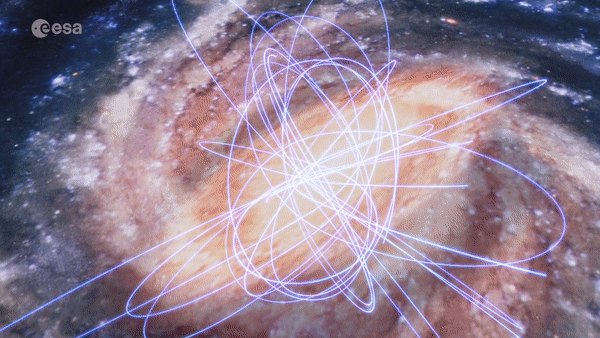Milky Way Galaxy Is 'Disturbed' and More Revealed in ESA Gaia Mission Data (Video)
The European Gaia spacecraft recently released a catalog of the positions of 1.7 billion stars, mapping our stellar neighbors around the Milky Way with unprecedented precision. The star map not only looks stunning but also includes a wealth of information about the evolution of our galaxy, the European Space Agency (ESA) said in a recent video.
The video, posted to YouTube in May, took place at the Paris Observatory. There, in 1887, astronomers attempted to map hundreds of thousands of stars in an effort called the Carte du Ciel (the Map of the Sky). Gaia is therefore part of a long line of star mappers, both on the ground and in space. But for all of our efforts, astronomers said in the video, we still have much to learn about the Milky Way — such as why certain stars' motion is "disturbed," and how the arms were formed.
Finnish astronomer Timo Prusti, Gaia project scientist, gestured toward Gaia's new map of the Milky Way and told video viewers what the spacecraft is revealing: "We see a flattened structure," he said. "That's the Milky Way; that's our Milky Way disk. We see some dark patches on top of it. What does it mean? It means that there, we see less stars. There are more stars [in that location], but there is dust in front of them, and that's why we don't see the stars." [Europe's Billion-Star Mapping Spacecraft Snaps 1st Photo (Image)]

But the spacecraft is also revealing some mysteries that will require further investigation. Previously, astronomers thought that the stars rotating around the Milky Way's center did so in an orderly fashion, no matter how far they were from our sun. Gaia, however, shows that some of these stars' motions are "disturbed," particularly for those that are far from the sun, Prusti said. Why that happens is a complete mystery.
Astronomers are also uncertain about how the arms of the Milky Way came to be, added François Mignard, one of the founders of Gaia and an emeritus director of research at French space agency CNRS.
"Were the arms born at the same time?" he asked in French, translated in voiceover to English. "Do the arms have a unique history? Are the arms a result of a merger with an external galaxy? It's these questions that people are going to try to answer, and the Gaia data is absolutely fundamental for this kind of study."
Gaia's April data release mapped 10,000 times more stars than its predecessor mission, Hipparcos. Frédéric Arenou, a senior research engineer at CNRS, said the new Gaia information includes the stars' luminosity, or how much light they produce. With that information in hand, astronomers will be able to learn more about the stars' physical properties, he added.
Get the Space.com Newsletter
Breaking space news, the latest updates on rocket launches, skywatching events and more!
Gaia's position in space is a huge asset in allowing it to map the sky. It is located 1.5 million kilometers (0.93 million miles) from Earth in the opposite direction to the sun. The spacecraft rotates around itself every 6 hours, and over time it can generate a complete map of the sky. Its three major instruments include an astrometric instrument to measure star positions, a photometer to map star colors and a spectrometer that shows stars' radial velocity — or the speed at which the stars move toward or away from Earth.
Gaia continues to send down measurements 11 hours a day, ESA officials said in the video, and several more data releases are expected in the next decade to address some of these outstanding scientific questions.
Follow us @Spacedotcom, Facebook and Google+. Original article on Space.com.
Join our Space Forums to keep talking space on the latest missions, night sky and more! And if you have a news tip, correction or comment, let us know at: community@space.com.

Elizabeth Howell (she/her), Ph.D., was a staff writer in the spaceflight channel between 2022 and 2024 specializing in Canadian space news. She was contributing writer for Space.com for 10 years from 2012 to 2024. Elizabeth's reporting includes multiple exclusives with the White House, leading world coverage about a lost-and-found space tomato on the International Space Station, witnessing five human spaceflight launches on two continents, flying parabolic, working inside a spacesuit, and participating in a simulated Mars mission. Her latest book, "Why Am I Taller?" (ECW Press, 2022) is co-written with astronaut Dave Williams.









